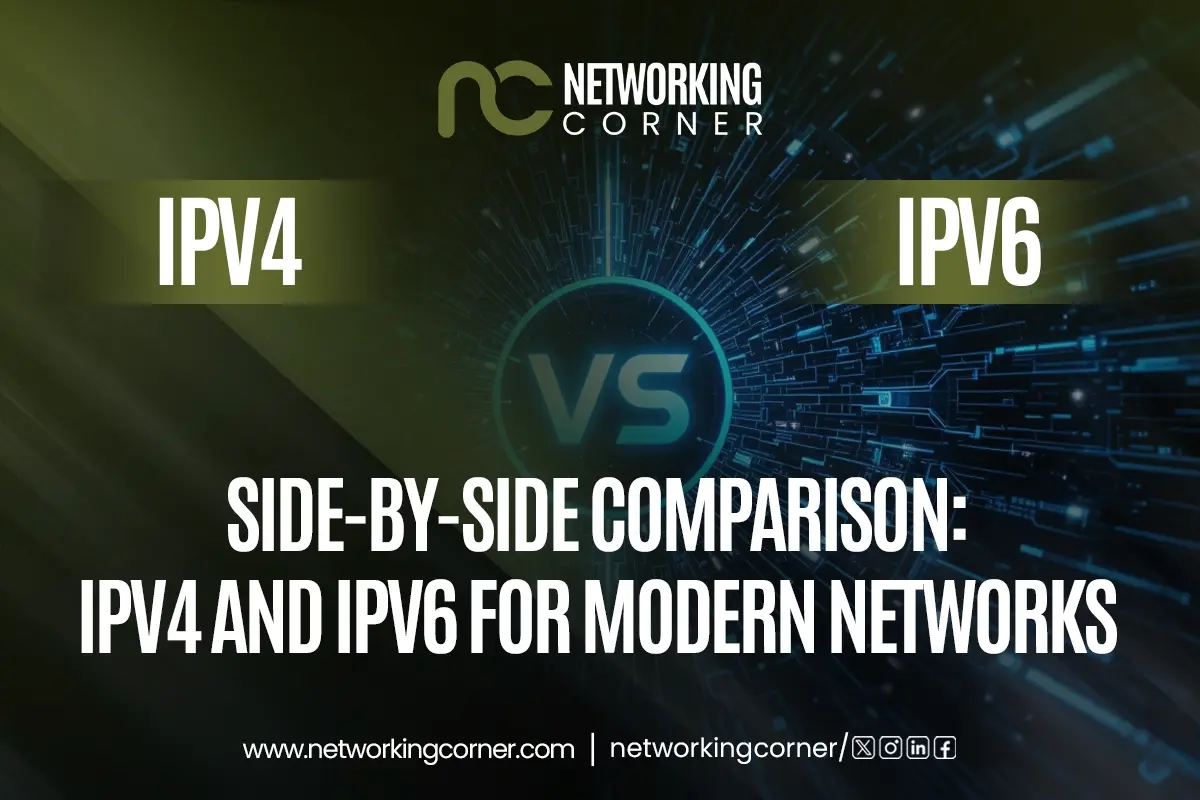- What is IPv4 vs IPv6?
- Difference Between IPv4 and IPv6
- IPv4 vs IPv6: Performance and Compatibility
- IPv4 vs IPv6 Pros and Cons
- Use Case Scenarios
- IPv4 to IPv6 Migration: Key Considerations
- What is IPv6 Used For?
- Migrating from IPv4 to IPv6: Best Practices
- Concluding IPv4 vs IPv6 – Which One Wins?
- FAQ’s

IP addressing is very important in the always changing terrain of digital connections for device communication across networks. Since the advent of the Internet, IPv4 to IPv6 represents one of the most important changes in network architecture. Understanding IPv4 and IPv6 becomes critical for IT professionals, companies, and even casual users as demand rises from billions of linked devices, from routers and switches to wireless controllers and security appliances.
We will side-by-side compare IPv4 vs IPv6 in this extensive blog article. We will also address crucial topics as "What is IPv6 used for?" investigate IPv4 vs IPv6 in computer networks, examine their advantages and disadvantages, and assist you in choosing the appropriate protocol for your company.
What is IPv4 vs IPv6?
IPv4: The Legacy Protocol
Designed in the early 1980s, IPv4, or Internet Protocol version 4, is the fourth iteration of the Internet Protocol. For decades, it has been the pillar of the Internet and is still extensively used today. With a 32-bit addressing system, IPv4 generates over 4.3 billion distinct IP addresses.
Key Features of IPv4:
- 32-bit address length (e.g., 192.168.0.1)
- Hierarchical addressing
- Broad support across routers, access points, and older server motherboards.
- Utilizes Network Address Translation (NAT) to manage address scarcity
- Simple and easy to configure
IPv6: The Next-Generation Protocol
IPv6 (Internet Protocol version 6) is the most recent version of the Internet Protocol. Developed by the Internet Engineering Task Force (IETF) in 1998, IPv6 was created to resolve the shortcomings of IPv4, primarily addressing exhaustion. IPv6 uses a 128-bit addressing scheme, offering a staggering 340 undecillion (3.4×10³⁸) possible IP addresses.
Key Features of IPv6:
- 128-bit address length (e.g., 2001:0db8:85a3:0000:0000:8a2e:0370:7334)
- Designed to replace IPv4 over time
- Eliminates the need for NAT by providing a unique IP for every device
- Supports built-in IPsec for better security
- More efficient packet routing and simplified header format
Difference Between IPv4 and IPv6
As the backbone of internet communication, IP (Internet Protocol) addresses are essential for identifying devices online. IPv4 (Internet Protocol version 4) and IPv6 (Internet Protocol version 6) are two versions of this protocol, and while they serve the same purpose, they differ significantly in structure, capacity, and efficiency.
IPv4 has been around since the early 1980s and uses a 32-bit address format, allowing for about 4.3 billion unique addresses. With the rapid growth of internet-connected devices, this pool of addresses has become nearly exhausted. That’s where IPv6 steps in.
IPv6 uses a 128-bit address format, supporting a mind-blowing 340 undecillion (that’s 340 followed by 36 zeros) unique addresses. This makes it far more scalable for the modern internet, especially with the rise of IoT (Internet of Things) devices.
Here’s a quick comparison:
|
Feature |
IPv4 |
IPv6 |
|
Address Length |
32 bits |
128 bits |
|
Address Format |
Numeric (e.g., 192.168.0.1) |
Alphanumeric (e.g., 2001:0db8::1) |
|
Total Addresses |
~4.3 billion |
~340 undecillion |
|
Header Complexity |
Simple |
More complex |
|
Security |
Optional (via IPSec) |
Built-in |
|
Configuration |
Manual or DHCP |
Auto-configuration supported |
|
NAT Requirement |
Yes |
No (end-to-end connectivity) |
While IPv4 is still widely used, the world is slowly transitioning to IPv6 due to its enhanced security, efficiency, and virtually unlimited address space. The change is gradual but crucial for the future of global internet infrastructure.
IPv4 vs IPv6: Performance and Compatibility
1. Network Integrity
Devices like routers, switches, and access points are being built with full IPv6 functionality more and more in contemporary IT systems. Companies using IoT-heavy or cloud-native infrastructure require the IPv6 address space and capabilities.
For many, nevertheless, IPv6's adoption is still a gradual process mostly owing to compatibility issues with legacy systems like outdated server motherboards and software apps.
2. Routing Efficiency and Performance
With flow labeling, greater multicast support, and simplified headers, IPv6 enhances packet routing. Particularly with high data volumes, these improvements lower latency and processing time in network firewalls and wireless controllers.
IPv4, on the other hand, depends mostly on NAT and suffers with ineffective routing, therefore adding more complexity and delay.
3. Device Interplay
IPv4 and IPv6 are supported on most contemporary server motherboards, routers, and switches. Older systems can need dual stack setups, that is, operating both protocols concurrently.
4. Viewpoints of Security
In networking, security has long been a worry; IPv6 solves many of IPv4's fundamental flaws.
IPv4
- IPv4 uses outside protocols such as IPsec for encryption.
- Subject to NAT-related weaknesses
- More easily prone to a spoofing attack
IPv6
- Designed-in IPsec capability for end-to-end encryption
- NAT simplifies packet tracking and auditing, which is not needed here.
- Improved IP-level authentication and encryption support
IPv4 vs IPv6 Pros and Cons
Advantages of IPv4
- Supported by every network device, routers, switches, and firewalls, wide adoption is possible.
- Mature infrastructure: Decades of use help to simplify troubleshooting.
- Works well with access points and older security equipment.
Disadvantages of IPv4
- Limited address space: NAT is one of the complicated solutions resulting from exhaustion.
- Security restrictions demand additional protocols, including IPsec.
- Bigger headers load routers with extra processing.
Advantages of IPv6
- Big address space: Perfect for IoT and cloud networks; no more shortage.
- IPsec guarantees encrypted communications by nature.
- Fixed header sizes help to enhance switch and router performance.
Disadvantages of IPv6
- Adoption issues: Certain older wireless controllers and server motherboards only provide partial compatibility.
- Transition difficulty calls for dual-stack setups during migration.
Use Case Scenarios
Small Business Networks
IPv4 remains a sensible option for smaller companies still depending on older routers, switches, and server motherboards. Its great adaptability and simplicity make it perfect for limited-scale installations.
Business Networking
Adopting IPv6 is helping companies, especially those with regionally dispersed, large-scale, cloud-based operations. Assigning unique IPs without NAT enhances security appliance and access point real-time communication, as well as transparency and scalability.
IoT and Smart Instruments
IPv6 is crucial for IoT use, especially. Billions of new devices, including smart thermostats, wearables, and industrial sensors, need quick, safe connectivity and unique IDs. IPv6 becomes quite crucial in this regard.
IPv4 to IPv6 Migration: Key Considerations
Double Stack Methodology
Most contemporary networks have a dual-stack design, letting IPv4 and IPv6 live together. This facilitates the change without upsetting current offerings. Routers and wireless controllers must be set to manage both protocols concurrently.
Compatibility of Hardware
Verify IPv6 support for all of your switches, routers, security appliances, and server motherboards. While most more recent models do, certain outdated systems might need firmware replacements or upgrades.
Policy of Network Security
Migrating to IPv6 calls for review of your security policies and network firewall. Built-in IPv6 capabilities include IPsec and multicast routing, alter traffic authentication and filtering. Especially when setting wireless controllers, access points, and other vital equipment, IT workers must be educated in IPv6 network management.
What is IPv6 Used For?
As the digital ecosystem expands rapidly, with billions of devices coming online, the limitations of IPv4 have become increasingly evident. IPv6 was developed not just to solve the issue of address exhaustion but also to support the future of networking across a wide range of applications.
1. Cloud Computing
IPv6 is natively supported by contemporary cloud systems such Google Cloud Platform (GCP), Microsoft Azure, and Amazon Web Services (AWS). Millions of virtual machines, containers, and microservices demanding global connection, auto-scaling, and security at scale abound on these systems.
Why is IPv6 cloud computing important?
- Releases NATs (Network Address Translation) reliance on
- Provides simplified routing and end-to-end addressability.
- Enhances APIs' and distributed applications' performance
- Improves security policies by using network firewalls' integrated IPv6 capabilities as security appliances
2. IoT Networks and 5G
IPv6 excels in one of the most transforming fields, that of 5G and the Internet of Things (IoT). Unique, routable addresses are becoming more important as billions of sensors, gadgets, and embedded systems join the internet.
Essential advantages of IPv6 in IoT and 5G:
- Every device receives a globally unique address; NAT is not needed.
- Facilitates safe, direct device-to-device communication.
- Lowers network overhead and advances effective multicast and anycast routing.
- More fit for low-power, wide-area networks
3. Business Networking
Big companies are adopting IPv6 for better security controls, simplified network design, and enhanced scalability.
Use cases in businesses include:
- Creating scalable VLANs and segments across many IPv6-aware routers and switches
- Using native IPv6 capability in security appliances helps to provide improved firewall settings.
- Guaranteeing the ongoing functioning of business-critical applications in mixed IPv4/IPv6 systems
- Streamlining BYOD (Bring Your Own Device) access across access points and wireless controllers as well as remote worker management
4. Military and Government Network
IPv6's security-first architecture and future-ready qualities have government agencies and military companies fast embracing it.
Why is IPv6 perfect for networks used in government security?
- Integrated IPsec capability for encrypted messaging
- Simplified addressing supporting flat and hierarchical topological designs
- More help for following cybersecurity standards (such as NIST, DISA)
- NAT's elimination increases network auditability and visibility.
Migrating from IPv4 to IPv6: Best Practices
Transitioning to IPv6 is a strategic initiative that requires careful planning, infrastructure readiness, and skilled personnel. Here are best practices for migrating from IPv4 to IPv6, especially in modern networks that rely on a variety of hardware like routers, switches, access points, and server motherboards.
1. Dual-Stack Deployment
The safest and most flexible method to begin IPv6 adoption is dual-stack networking. This approach enables devices to operate with both IPv4 and IPv6 simultaneously.
Key implementation steps:
- Configure routers, switches, and wireless controllers to support dual-stack mode.
- Verify correct configuration of DHCPv6 and SLAAC (Stateless Address Auto Configuration).
- For host resolution use dual-stack DNS records (A and AAAA).
- Track IPv4 and IPv6 traffic to gauge adoption and the performance.
2. Improve Hardware for Networks
Many older devices require firmware upgrades for safe performance or IPv6 functionality. Review and modernize the elements.
Checklist of Elements:
- Make sure Routers and Layer 3 switches should support IPv6 routing technologies, including MP-BGP, EIGRP, or OSPFv3.
- Update firmware and settings to allow the IPv6 wireless SSIDs and routing for access points and wireless controllers.
- Verify IPv6 functionality for VPNs, intrusion prevention systems and filtering rules.
- Verify IPv6 capability at hardware and OS levels for both real and the virtualized environments on server motherboards and BIOS.
3. Test Policies for Security
IPv6 changes security paradigms drastically. The absence of NAT alters the operation of IP-based filtering and logging.
Implement Security Measures to:
- Security policy testing covers updating IPv6 traffic firewall rules and ACLs (access control lists).
- Ensure that security equipment can examine and filter IPv6 traffic.
- Looking for IPv6-specific vulnerabilities, including attacks through rogue RA (Router Advertisement).
- As necessary, enforcing IPsec tunnels.
4. Lead IT Teams
An orderly switch to IPv6 relies on a ready-made IT staff. Training is critical as IPv6 brings fresh diagnostics tools, routing protocols and addressing systems.
Suggested methods of training:
- Show network engineers DHCPv6, SLAAC and IPv6 subnetting.
- Teach system managers dual-stack server and service configuration.
- Practice IPv6 layouts on routers, switches and wireless controllers in simulation laboratories.
- Using tools like ping6, traceroute6 and ip-6 commands, update NOC and assist desk workers on IPv6 issues.
Concluding IPv4 vs IPv6 – Which One Wins?
IPv6 is the future of networking even if legacy infrastructure keeps IPv4 dominant. IPv6 is the superior fit for contemporary networks driven by routers, switches, firewalls, and IoT devices because of its increased address space, built-in security, and efficiency.
Companies should progressively switch to IPv6 keeping dual-stack support to guarantee compatibility. IPv6 will become the norm as 5G, IoT, and cloud computing expand; hence, now is the ideal moment to be ready for this change in standard.
FAQ’s
Should I Use IPv6 or IPv4?
Your present network environment and future objectives will determine whether IPv6 or IPv4 you should choose. Although IPv4 is still the norm as it is widely compatible, IPv6 has major benefits like more address space, more security, better routing. Most companies find that running IPv4 and IPv offers a seamless change without compromising legacy support.
Why Is IPv6 Better Than IPv4?
In several technological respects, IPv6 excels above IPv4. It removes NAT (Network Address Translation) by offering almost infinite IP addresses. For current network firewalls, security appliances, and wireless controllers, its simplified header architecture lets more effective packet processing increase performance.
What Is the Better IP Version for VoIP: IPv4 or IPv6?
IPv6 reduces NAT latency, improves packet routing, and permits direct addressing, making it superior for VoIP on advanced networks. Improvements minimize latency, improve call quality, and strengthen connections. Dual-stack routers, switches, and security appliances are suggested for compatibility and performance during the transition since many VoIP providers and networks still use IPv4.
How to Know and Where to Check If You Have IPv4 or IPv6?
Users of a device may check their network setup to see if IPv4 or IPv6 is being used. Running the ipconfig command on Windows systems will show IPv4 and IPv6 addresses if present. Users of Linux and macOS may use ifconfig or ip a via the terminal. Easy browser-based identification also comes via web programs like test-ipv6.com or whatismyxaddress.com.
How to Change My Router from IPv6 to IPv4?
Accessing the administrative web interface of their router allows users to convert IPv6 to IPv4. They may deactivate IPv6 or choose IPv4-only mode by navigating to the network or internet settings part after login. This adjustment could call for a reboot to start working. Before turning off IPv6, make sure your ISP supports IPv4-only operation.





